The founders of Salt Lake City-based CRSA, Wally Cooper and Allen Roberts, are now retired from the architectural firm they established more than 45 years ago, but their legacy lives on as the second generation of leadership celebrates some of the firm’s greatest successes.
Now led by President Ben Rogers, three additional managing principals and a broader leadership team, the firm has grown to a staff of nearly 60, seeing its annual revenue increase to more than $21 million in 2020, nearly 15% above 2019.
Originally launched with a focus on historic preservation, Cooper/Roberts Architecture built a strong reputation from its work on restoration projects, using that experience to break into the cultural, higher education and civic markets CRSA still is known for today. The addition of Soren Simonsen as a partner in 2000 resulted in a firm name change to CRSA and brought landscape architecture to the firm’s established services of architecture, interior design and planning.
CRSA has taken advantage of the tremendous growth across Utah and the Intermountain West to break into newer, developer-led markets like the multifamily and mixed-use sectors as well as office and workplace strategy design.
“We had a great year last year; the best we’ve ever had,” Rogers says.
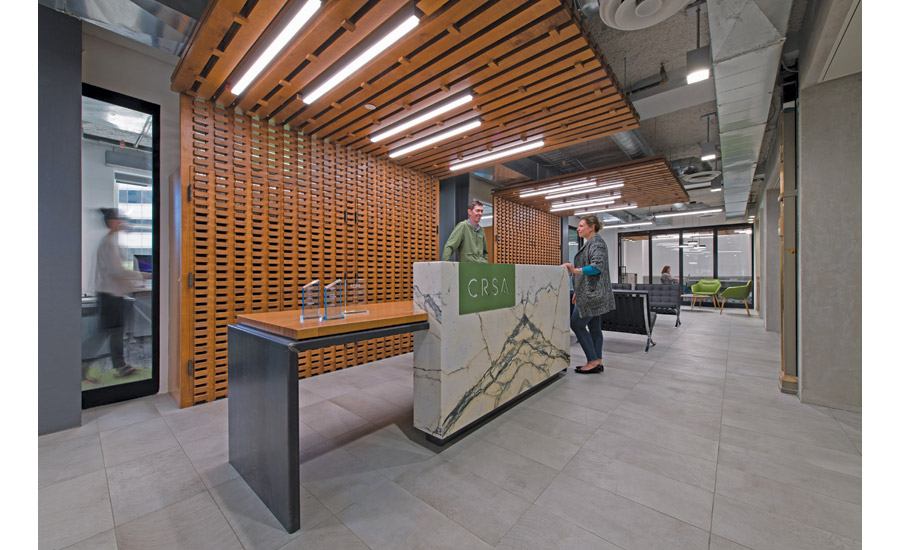
NOSTALGIC COMPONENTS Design of CRSA’s new Salt Lake City headquarters incorporates marble accents to celebrate and preserve the original design features of Utah’s historic Walker Center.
Image courtesy of CRSA
Purposeful Transition
The firm’s transition to its second generation of leadership is still a work in progress that started with the founders fully stepping back from the firm in 2018 and Rogers being named president, says Laura Reid, chief financial officer and director of human resources for the firm. She says they’ve been managing it well, and profitably, but that “we still have some transition to go.”
The new leadership team’s vision includes a goal “to establish ourselves apart from our founders,” Rogers says. The leadership team brought in consultants to help them improve company standards, productivity and profitability. “The firm set up a profit-sharing program, which helped incentivize our employees and senior principals and managers,” Rogers says.
At the beginning of 2020, the firm was starting to realize several milestones that represented this transition, such as moving out of their space in the building owned by their founders to a headquarters in downtown Salt Lake City, creating a new home on the internet with a complete webpage overhaul and formalizing a market sector for workplace strategy consulting.
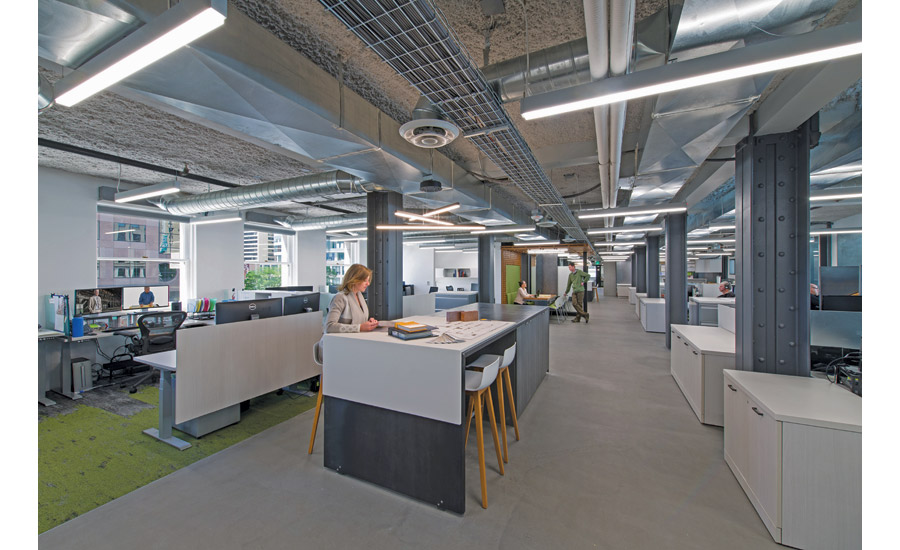
AMPLE SPACE CRSA’s new workspace allows the firm to showcase its designs for innovative offices that incorporate the latest workplace strategies.
Image courtesy of CRSA
Though COVID-19 left some firms in the AEC industry scrambling to adjust to remote work, CRSA’s efforts to improve productivity included the foresight to explore web-based desktop and server solutions. In the fall of 2019, as the firm began designing its new office, leaders conducted an analysis that included a cost-per-station comparison against a fully cloud-based system. The research showed the cloud was not only a viable option to reduce upfront hardware costs but also provided more flexibility for staff in various life situations, whether they were working in the headquarters or in CRSA’s St. George, Utah, office or traveling across the Mountain West for project-related work.
By early 2020, “We were at the point where we needed to decide whether we were going with this or not,” Rogers says, adding that when COVID hit, it really made the decision for them. “But we were in an excellent position,” he says, adding, “We were already set up, had our server on the cloud, and all we had to do was set up the remote workstations and we were able to work essentially the same way as we did in the office.”
Both Rogers and Reid say they saw no negative impacts to productivity from working in the cloud. “We didn’t really have issues at all, and our metrics actually went up,” Reid adds.
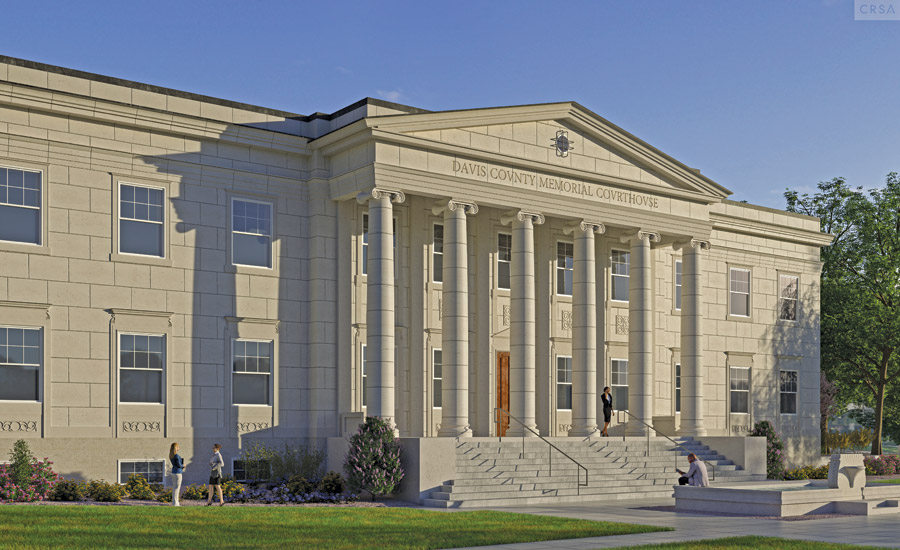
HISTORIC CARE Restoration of Davis County Memorial Courthouse will demolish previous additions and reestablish the interior to its 1932 appearance.
Image courtesy of CRSA
Avenues to a New Service
Having an effective and adaptable workplace strategy is critical for many businesses in Utah due to the area’s extensive growth and high competition for talent. COVID has forced many organizations to review their real estate assets, costs and mobility needs after a year of remote work.
That includes the state of Utah, which recently began looking for ways to better leverage its existing and planned spaces. The state turned to CRSA, which partnered with Emergent Solutions Organizational Design Labs (ESODL) to complete a space utilization study of 2.6 million sq ft of state office space in 2018. The study aimed to help the state’s Dept. of Facilities and Construction Management (DFCM) understand “how it could more efficiently use its real estate resources,” says Kathy Wheadon, managing principal for the higher education market at CRSA and a specialist in workplace strategy.
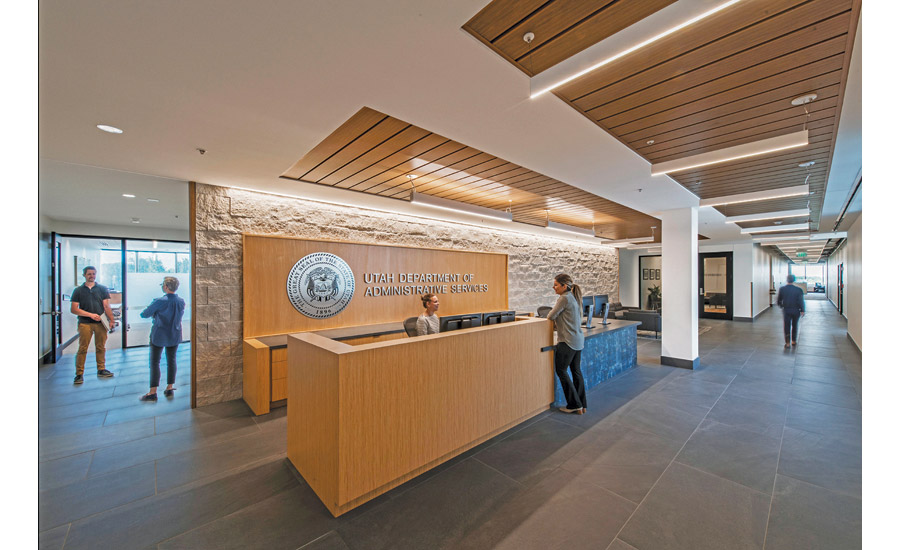
FLEXIBILITY Design of the Taylorsville State Office Building allowed CRSA to implement new design standards for the workplace, including more employee mobility for dozens of state departments.
Image courtesy of CRSA
was also during the time when DFCM needed to shift nearly 700 employees from the 60-year-old, soon-to-be-demolished State Office Building to a nearby campus it had purchased from American Express.
Wheadon says all sorts of organizations, whether private or public, are interested in employee recruitment and retention, and she gets excited about “the component piece of architecture, which is creating a great workspace where people want to come to work and that makes them more productive,” she says.
Wheadon says the study results showed that state employees “want to be there, they want to do great work, they want to work collaboratively with their teammates, they really want to deliver great services.”
She adds, “You get a lot out of your employees when they’re happy.”
Wheadon credits the firm’s work on the study with leading to additional contracts with the state for an update to its space standards as well as design for more than 400,000 sq ft of space. She noted the effort also is an opportunity to improve workforce equity by including opportunities for rural Utahns as well.
“Mobility is a huge driver,” says Wheadon. “Mobility isn’t just sending people to work from home but thinking about who comes into the office and how to support them. They need the staff and want an innovative and creative workforce,” she says, stressing the importance of having a space that responds to those needs.

CONNECTIONS CRSA assisted in developing the architectural design guide for the Washington, D.C., LDS temple. Multiple precedents and design solutions were tested to better connect the interior and exterior character of the building.
Image courtesy Church of Jesus Christ of Latter-day Saints
Traditional Markets Steady
While the firm’s experience in workplace strategy and other new developer-led markets is growing and evolving, the outlook for its more traditional project types is bullish as well. This is due in part to the market, Rogers says, but also because of the firm’s reputation for providing both service and design.
A long-term client who agrees is Chris Robbins, senior project manager with The Church of Jesus Christ of Latter-day Saints. Robbins was first exposed to CRSA earlier in his career as a consultant, before he came to work managing special projects for the LDS. “I was impressed from their early days by the founders,” he says, adding that he is currently working with the firm on three projects, all of which involve historic remodels and renovations.
Those include a full remodel and a multiyear historic restoration of more than 100,000 sq ft scheduled to start construction later this year at the Manti Temple originally built in Manti, Utah, in 1888. CRSA also is in the middle of construction administration for upgrades it designed for the 210,000-sq-ft St. George Temple, the oldest operating LDS temple, originally dedicated in 1877.

INTERNATIONAL REACH CRSA provided architecture and planning for the 33,000-sq-ft temple in Tijuana, Mexico, for The Church of Jesus Christ of Latterday Saints.
Image courtesy Church of Jesus Christ of Latter-day Saints
“They’re great collaborators,” says Robbins. “They know how to staff the team right,” especially for the challenging kinds of historical renovation projects he manages. Robbins adds that unforeseen conditions or the lack of as-builts are typical challenges they encounter when trying to upgrade facilities while maintaining their historical integrity.
“The kind of work we do, it takes a lot of interaction, creative thinking, solution-oriented solving, plus good architecture,” he says. “Both [CRSA’s] St. George and Salt Lake City offices have been very collaborative on their approach to these challenges.”
The firm’s leadership concurs with Robbins that the firm is capable of bringing diverse perspectives and areas of expertise together in a collaborative manner to get the work done. These differences among members of the CRSA team “are one of the things that makes us great,” says Reid.
“I love coming to work every day,” says Wheadon, the most-tenured of the firm’s managing principals. “I think I’m surrounded by the most brilliant, hard-working, invested, creative folks, and I find the greatest pleasure when I can sit back and let them shine.”


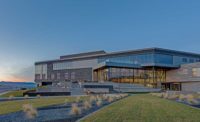

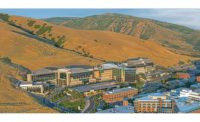
Post a comment to this article
Report Abusive Comment